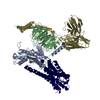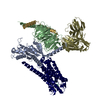+ Open data
Open data
- Basic information
Basic information
| Entry | Database: PDB / ID: 8zjd | ||||||
|---|---|---|---|---|---|---|---|
| Title | Cryo-EM structure of kisspeptin receptor bound to KP-10 | ||||||
 Components Components |
| ||||||
 Keywords Keywords | MEMBRANE PROTEIN / Cryo-EM / kisspeptin receptor / GPR54 / KISS1R / G proteins | ||||||
| Function / homology |  Function and homology information Function and homology informationFatty Acids bound to GPR40 (FFAR1) regulate insulin secretion / Acetylcholine regulates insulin secretion / phospholipase C-activating G protein-coupled glutamate receptor signaling pathway / neuropeptide receptor activity / phospholipase C-activating serotonin receptor signaling pathway / PLC beta mediated events / regulation of platelet activation / entrainment of circadian clock / G protein-coupled peptide receptor activity / regulation of canonical Wnt signaling pathway ...Fatty Acids bound to GPR40 (FFAR1) regulate insulin secretion / Acetylcholine regulates insulin secretion / phospholipase C-activating G protein-coupled glutamate receptor signaling pathway / neuropeptide receptor activity / phospholipase C-activating serotonin receptor signaling pathway / PLC beta mediated events / regulation of platelet activation / entrainment of circadian clock / G protein-coupled peptide receptor activity / regulation of canonical Wnt signaling pathway / glutamate receptor signaling pathway / phototransduction, visible light / photoreceptor outer segment / neuropeptide signaling pathway / postsynaptic cytosol / adenylate cyclase inhibitor activity / positive regulation of protein localization to cell cortex / T cell migration / Adenylate cyclase inhibitory pathway / enzyme regulator activity / D2 dopamine receptor binding / response to prostaglandin E / adenylate cyclase regulator activity / G protein-coupled serotonin receptor binding / adenylate cyclase-inhibiting serotonin receptor signaling pathway / cellular response to forskolin / GTPase activator activity / regulation of mitotic spindle organization / Peptide ligand-binding receptors / Turbulent (oscillatory, disturbed) flow shear stress activates signaling by PIEZO1 and integrins in endothelial cells / Regulation of insulin secretion / positive regulation of cholesterol biosynthetic process / negative regulation of insulin secretion / G protein-coupled receptor binding / response to peptide hormone / adenylate cyclase-inhibiting G protein-coupled receptor signaling pathway / adenylate cyclase-modulating G protein-coupled receptor signaling pathway / centriolar satellite / G-protein beta/gamma-subunit complex binding / Olfactory Signaling Pathway / Activation of the phototransduction cascade / adenylate cyclase-activating G protein-coupled receptor signaling pathway / G beta:gamma signalling through PLC beta / Presynaptic function of Kainate receptors / Thromboxane signalling through TP receptor / G protein-coupled acetylcholine receptor signaling pathway / Activation of G protein gated Potassium channels / Inhibition of voltage gated Ca2+ channels via Gbeta/gamma subunits / G-protein activation / Prostacyclin signalling through prostacyclin receptor / G beta:gamma signalling through CDC42 / Glucagon signaling in metabolic regulation / G beta:gamma signalling through BTK / blood coagulation / Synthesis, secretion, and inactivation of Glucagon-like Peptide-1 (GLP-1) / ADP signalling through P2Y purinoceptor 12 / photoreceptor disc membrane / Sensory perception of sweet, bitter, and umami (glutamate) taste / Glucagon-type ligand receptors / Adrenaline,noradrenaline inhibits insulin secretion / Vasopressin regulates renal water homeostasis via Aquaporins / GDP binding / Glucagon-like Peptide-1 (GLP1) regulates insulin secretion / G alpha (z) signalling events / cellular response to catecholamine stimulus / ADORA2B mediated anti-inflammatory cytokines production / ADP signalling through P2Y purinoceptor 1 / G beta:gamma signalling through PI3Kgamma / adenylate cyclase-activating dopamine receptor signaling pathway / Cooperation of PDCL (PhLP1) and TRiC/CCT in G-protein beta folding / GPER1 signaling / Inactivation, recovery and regulation of the phototransduction cascade / cellular response to prostaglandin E stimulus / G-protein beta-subunit binding / heterotrimeric G-protein complex / G alpha (12/13) signalling events / sensory perception of taste / extracellular vesicle / signaling receptor complex adaptor activity / Thrombin signalling through proteinase activated receptors (PARs) / retina development in camera-type eye / G protein activity / GTPase binding / Ca2+ pathway / fibroblast proliferation / midbody / High laminar flow shear stress activates signaling by PIEZO1 and PECAM1:CDH5:KDR in endothelial cells / cell cortex / nuclear membrane / G alpha (i) signalling events / G alpha (s) signalling events / phospholipase C-activating G protein-coupled receptor signaling pathway / G alpha (q) signalling events / Hydrolases; Acting on acid anhydrides; Acting on GTP to facilitate cellular and subcellular movement / Ras protein signal transduction / Extra-nuclear estrogen signaling / cell population proliferation / protein stabilization / cilium / ciliary basal body Similarity search - Function | ||||||
| Biological species |  Homo sapiens (human) Homo sapiens (human) synthetic construct (others) | ||||||
| Method | ELECTRON MICROSCOPY / single particle reconstruction / cryo EM / Resolution: 3.06 Å | ||||||
 Authors Authors | Shen, S. / Liu, H. / Xu, H.E. | ||||||
| Funding support |  China, 1items China, 1items
| ||||||
 Citation Citation |  Journal: Cell Rep / Year: 2024 Journal: Cell Rep / Year: 2024Title: Structural basis for hormone recognition and distinctive Gq protein coupling by the kisspeptin receptor. Authors: Shiyi Shen / Dongxue Wang / Heng Liu / Xinheng He / Yinglong Cao / Juanhua Chen / Shujie Li / Xi Cheng / H Eric Xu / Jia Duan /  Abstract: Kisspeptin signaling through its G protein-coupled receptor, KISS1R, plays an indispensable role in regulating reproduction via the hypothalamic-pituitary-gonadal axis. Dysregulation of this pathway ...Kisspeptin signaling through its G protein-coupled receptor, KISS1R, plays an indispensable role in regulating reproduction via the hypothalamic-pituitary-gonadal axis. Dysregulation of this pathway underlies severe disorders like infertility and precocious puberty. Here, we present cryo-EM structures of KISS1R bound to the endogenous agonist kisspeptin-10 and a synthetic analog TAK-448. These structures reveal pivotal interactions between peptide ligands and KISS1R extracellular loops for receptor activation. Both peptides exhibit a conserved binding mode, unveiling their common activation mechanism. Intriguingly, KISS1R displays a distinct 40° angular deviation in its intracellular TM6 region compared to other G-coupled receptors, enabling distinct interactions with G. This study reveals the molecular intricacies governing ligand binding and activation of KISS1R, while highlighting its exceptional ability to couple with G. Our findings pave the way for structure-guided design of therapeutics targeting this physiologically indispensable receptor. | ||||||
| History |
|
- Structure visualization
Structure visualization
| Structure viewer | Molecule:  Molmil Molmil Jmol/JSmol Jmol/JSmol |
|---|
- Downloads & links
Downloads & links
- Download
Download
| PDBx/mmCIF format |  8zjd.cif.gz 8zjd.cif.gz | 240.8 KB | Display |  PDBx/mmCIF format PDBx/mmCIF format |
|---|---|---|---|---|
| PDB format |  pdb8zjd.ent.gz pdb8zjd.ent.gz | 183.7 KB | Display |  PDB format PDB format |
| PDBx/mmJSON format |  8zjd.json.gz 8zjd.json.gz | Tree view |  PDBx/mmJSON format PDBx/mmJSON format | |
| Others |  Other downloads Other downloads |
-Validation report
| Arichive directory |  https://data.pdbj.org/pub/pdb/validation_reports/zj/8zjd https://data.pdbj.org/pub/pdb/validation_reports/zj/8zjd ftp://data.pdbj.org/pub/pdb/validation_reports/zj/8zjd ftp://data.pdbj.org/pub/pdb/validation_reports/zj/8zjd | HTTPS FTP |
|---|
-Related structure data
| Related structure data |  60141MC  8zjeC M: map data used to model this data C: citing same article ( |
|---|---|
| Similar structure data | Similarity search - Function & homology  F&H Search F&H Search |
- Links
Links
- Assembly
Assembly
| Deposited unit | 
|
|---|---|
| 1 |
|
- Components
Components
-Guanine nucleotide-binding protein ... , 3 types, 3 molecules BGA
| #3: Protein | Mass: 38744.371 Da / Num. of mol.: 1 Source method: isolated from a genetically manipulated source Source: (gene. exp.)  Homo sapiens (human) / Gene: GNB1 / Production host: Homo sapiens (human) / Gene: GNB1 / Production host:  |
|---|---|
| #5: Protein | Mass: 7861.143 Da / Num. of mol.: 1 Source method: isolated from a genetically manipulated source Source: (gene. exp.)  Homo sapiens (human) / Gene: GNG2 / Production host: Homo sapiens (human) / Gene: GNG2 / Production host:  |
| #6: Protein | Mass: 41312.922 Da / Num. of mol.: 1 Source method: isolated from a genetically manipulated source Details: fusion protein of Guanine nucleotide-binding protein G(i) subunit alpha-1 and Guanine nucleotide-binding protein G(q) subunit alpha-q. Source: (gene. exp.)  Homo sapiens (human) / Gene: GNAI1, GNAQ, GAQ / Production host: Homo sapiens (human) / Gene: GNAI1, GNAQ, GAQ / Production host:  |
-Protein / Protein/peptide / Antibody , 3 types, 3 molecules RLS
| #1: Protein | Mass: 55953.941 Da / Num. of mol.: 1 Source method: isolated from a genetically manipulated source Source: (gene. exp.)  Homo sapiens (human) / Gene: KISS1R, AXOR12, GPR54 / Production host: Homo sapiens (human) / Gene: KISS1R, AXOR12, GPR54 / Production host:  Trichoplusia ni (cabbage looper) / References: UniProt: Q969F8 Trichoplusia ni (cabbage looper) / References: UniProt: Q969F8 |
|---|---|
| #2: Protein/peptide | Mass: 1375.511 Da / Num. of mol.: 1 / Source method: obtained synthetically / Source: (synth.) synthetic construct (others) |
| #4: Antibody | Mass: 26277.299 Da / Num. of mol.: 1 Source method: isolated from a genetically manipulated source Source: (gene. exp.)   |
-Details
| Has protein modification | Y |
|---|
-Experimental details
-Experiment
| Experiment | Method: ELECTRON MICROSCOPY |
|---|---|
| EM experiment | Aggregation state: PARTICLE / 3D reconstruction method: single particle reconstruction |
- Sample preparation
Sample preparation
| Component | Name: Cryo-EM structure of kisspeptin receptor in complex with G proteins Type: COMPLEX / Entity ID: all / Source: RECOMBINANT |
|---|---|
| Source (natural) | Organism:  Homo Sapiens (human) Homo Sapiens (human) |
| Source (recombinant) | Organism:  |
| Buffer solution | pH: 7.4 |
| Specimen | Embedding applied: NO / Shadowing applied: NO / Staining applied: NO / Vitrification applied: YES |
| Vitrification | Cryogen name: ETHANE |
- Electron microscopy imaging
Electron microscopy imaging
| Experimental equipment |  Model: Titan Krios / Image courtesy: FEI Company |
|---|---|
| Microscopy | Model: FEI TITAN KRIOS |
| Electron gun | Electron source:  FIELD EMISSION GUN / Accelerating voltage: 300 kV / Illumination mode: FLOOD BEAM FIELD EMISSION GUN / Accelerating voltage: 300 kV / Illumination mode: FLOOD BEAM |
| Electron lens | Mode: DARK FIELD / Nominal defocus max: 2000 nm / Nominal defocus min: 1000 nm |
| Image recording | Electron dose: 50 e/Å2 / Film or detector model: FEI FALCON IV (4k x 4k) |
- Processing
Processing
| CTF correction | Type: NONE |
|---|---|
| 3D reconstruction | Resolution: 3.06 Å / Resolution method: FSC 0.143 CUT-OFF / Num. of particles: 199591 / Symmetry type: POINT |
 Movie
Movie Controller
Controller




 PDBj
PDBj































